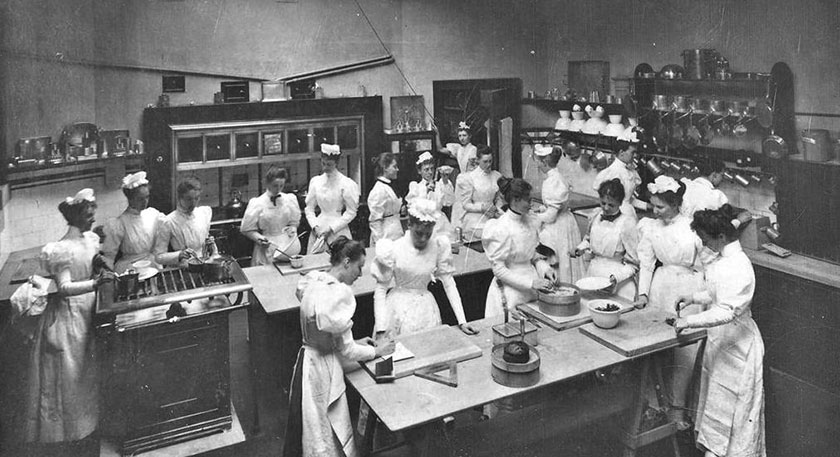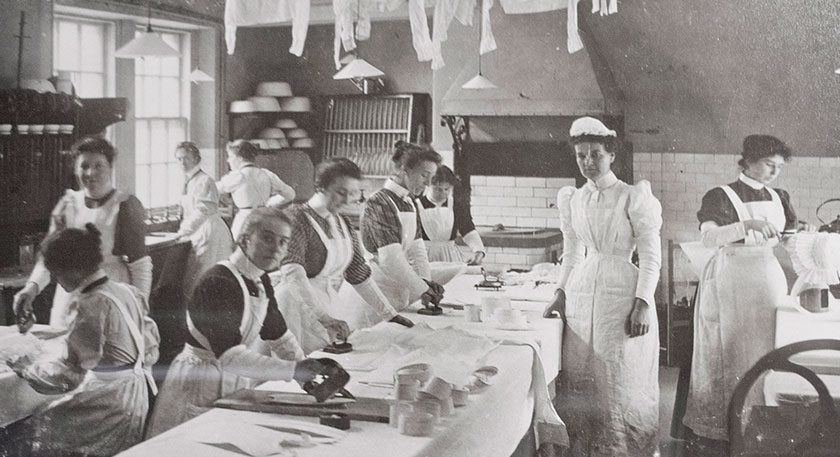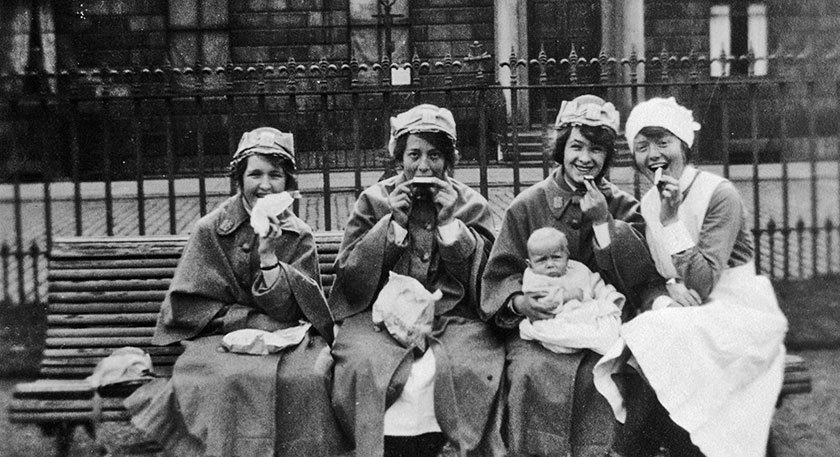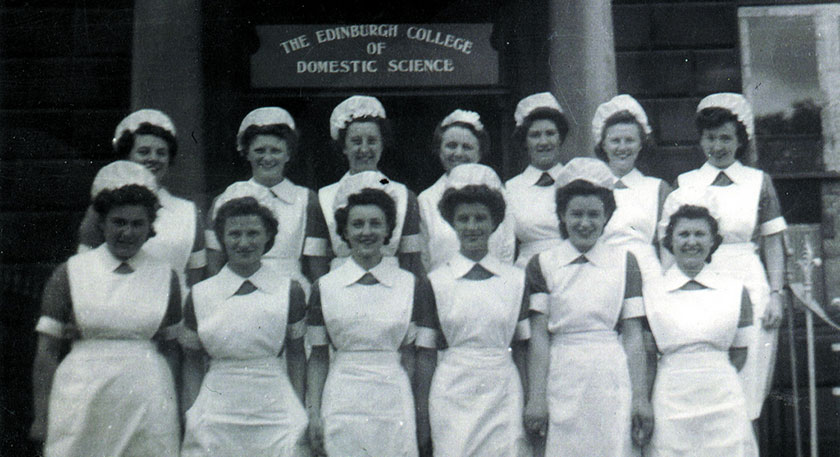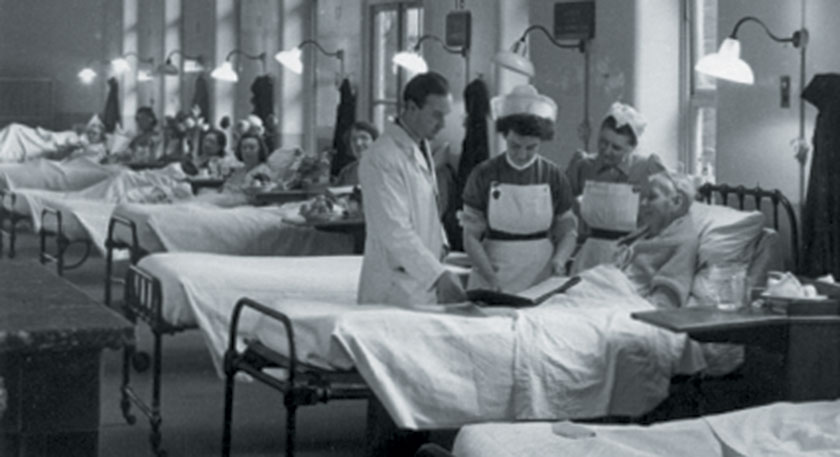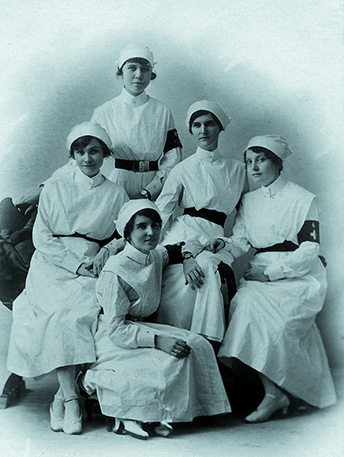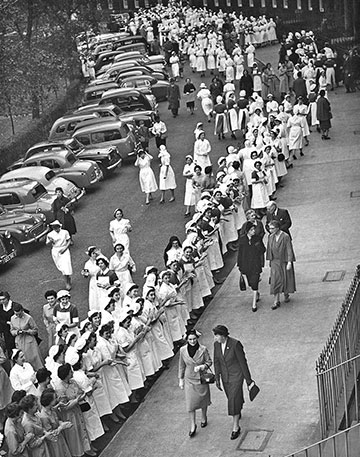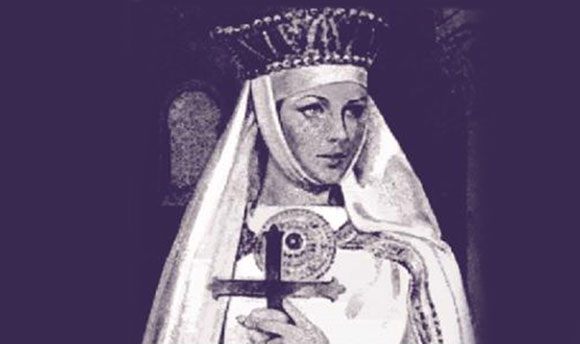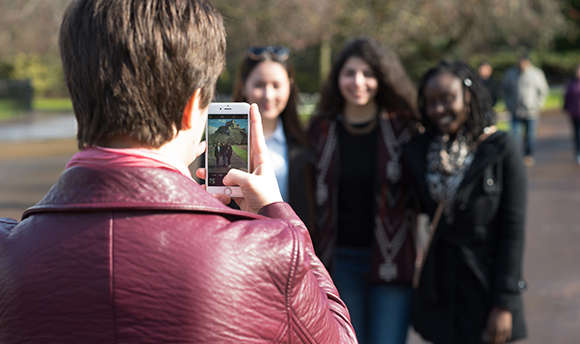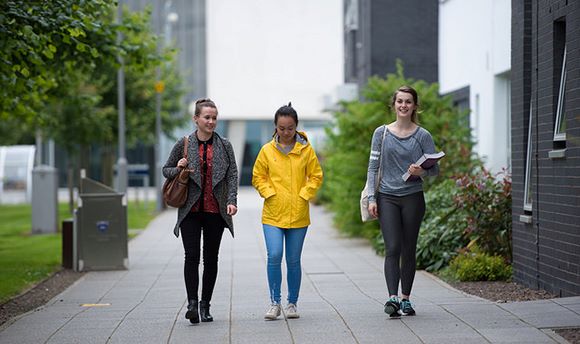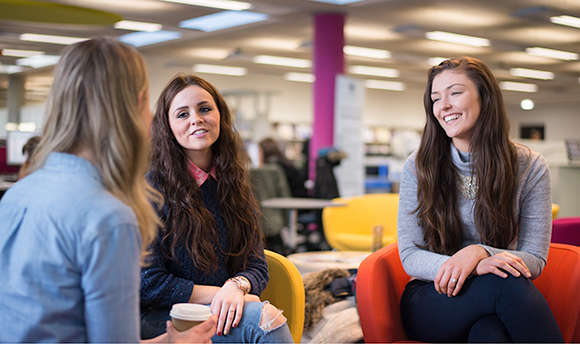History
Our History in Short
We have a proud history of achievement and progress extending for well over a century.
Founded in 1875, we have always been driven by the highest ideals and purposes, focusing on contributing in practical ways to improving people’s lives and serving the community.
Our Beginnings
The institution now named Queen Margaret University was established as the Edinburgh School of Cookery in 1875.
This institution emerged in a period that was notable for real economic progress, but also characterised by many social and economic divisions and inequalities, and widespread poverty. The School was established as a voluntary effort to address two key problems facing society at the time:
(1) To provide educational opportunities for women. The institution’s founders were part of the U.K.-wide mid Victorian "Women's Movement", which was a campaign for better education and improved career opportunities for females. A main element of this campaign was directed at securing equality of opportunity for school girls, but another purpose was to open up post-school education at both university and technical levels. To this point young women had been excluded from higher and technical education, with an inevitable consequence being widespread female poverty. (One of the key leaders of the women's movement was Queen Victoria's fourth daughter, Princess Louise, Duchess of Argyll, and she became the School's leading patron.)
(2) The need to bring about an improvement in diets, particularly the diets of working class families.
The original lectures took place (before huge audiences) in the Royal Museum in Edinburgh’s Chambers Street, but it was at first peripatetic in nature, in that teaching staff went out with mobile gas and paraffin cooking equipment to give programmes of public lectures and demonstrations all over Britain, from the Shetlands to the Channel Islands. The first generation of lecturers were almost all young women aged in their early twenties and almost everywhere they went they drew large gatherings of women eager for instruction.
The first permanent site was in Shandwick Place, where the institution was based from 1877 to 1891. At this time the institution also operated a branch in Manchester to provide lectures to industrial communities throughout the north of England. As was intended by the founders, this branch eventually became independent and it is now a constituent part of Manchester Metropolitan University.
Our Founders

The main founders of the school were Christian Guthrie Wright and Louisa Stevenson (Louisa was sister of Flora Stevenson, the first female Chair of the Edinburgh School Board). These women were also largely responsible for leading the campaign to secure the admission of females to the University of Edinburgh. In setting up the School of Cookery, they were backed by various interest groups, but particularly enlightened local medical practitioners and Church leaders.
In 1879 Guthrie Wright collaborated with the scientist Sir Thomas Dyke Acland and two "distinguished medical doctors" (probably Dr Henry Littlejohn - Edinburgh's first Medical Officer of Health - and Dr Alexander Wood) to produce her School Cookery Book. Published as part of a series of science primers under the general editorship of the naturalist, Professor T.H. Huxley, and including texts by such individuals as Sir H. E. Roscoe (chemistry), Sir Archibald Geikie (geography and geology) and W. Stanley Jevons (logic and political economy), Guthrie Wright's book effectively represented the state of knowledge at the time in respect of food. It subsequently ran into many editions.
Our Founders’ Links to the District Nursing Service
About 1887 Guthrie Wright Louisa Stevenson and Princess Louise also collaborated in developing in Scotland Queen Victoria's Jubilee Institute for Nurses. Also an entirely voluntary body the organisation established training and residential facilities in Edinburgh and Glasgow to prepare nurses to provide care to the sick poor in their own homes. Effectively this was the beginning of the district nursing service and it was a vital initiative in the period prior to the creation of the National Health Service.
Expansion and Relocation to Atholl Crescent
In 1891 the School moved to Atholl Crescent in Edinburgh and over the next fifty years or so gradually extended its premises along the Crescent. At different times it also had properties in other locations in Edinburgh, including Rothesay Terrace, and it ran industrial classes in the India Buildings in the city’s Victoria Street.
From 1891 the School developed extended courses and offered places to residential students. It received no public funding and had to operate on the basis of subscriptions from supporters and the fees of students. The fees paid by middle class students training to be schoolteachers and housekeepers were used to subsidise classes for hundreds of working class teenagers and adults.
For many years the authorities resisted the efforts of Guthrie Wright and her colleagues to have cookery classes introduced into the ordinary public day schools. (Male dominated school boards did not want to find the money to install cooking equipment and did not want to pay for the ingredients that the children would require to use.) However, medical studies in the early 1900s showed that thousands of urban children all over the U.K. were desperately undernourished and unhealthy.
One of the most influential pioneering investigations was conducted by the Medical Inspector at the Scottish Office, Sir W. Leslie MacKenzie and his wife Helen, a lecturer in the School (and, later, Chairman of Governors). The MacKenzies showed conclusively that children attending schools in the poorest parts of Edinburgh were much smaller and lighter than children from middle class areas and that astonishingly high proportions suffered from significant medical defects. The main causes of the problems were identified as poor housing, overcrowding, lack of adequate nutrition and ignorance of food, health, hygiene and child care among mothers.
Following two Royal Commissions to which the MacKenzies reported, from 1908 school children became subject to regular medical inspection. But in addition, cookery classes and physical education were both made compulsory in state schools and in 1909 what had now become the Edinburgh School of Domestic Science was taken under direct Government control to train appropriate teachers. At this time the first professional Principal, Miss Ethel de la Cour, was appointed.
The student population grew rapidly over the next few years and the Atholl Crescent became world renowned as setting the standards for the training of domestic science teachers.
World Wars
During the two world wars the College performed some important duties. These included training staff to provide the catering on military and Air Force camps; and producing advice during the formation of rationing allowances and drawing up guidance for households on how to make the most of chronically scarce food supplies.
Throughout the Second War the residences were crammed with students from all over Britain, many being sent by parents to what was perceived to be the relative safety of Edinburgh.
Perhaps the College's "finest hour" was in 1944 when, at the request of the Secretary of State, relays of final year students were sent down to London (at a time of heavy "flying bomb" attacks) to take over and run a hotel for bomb repair workers. These building workers from all over the country had been downing tools and returning home because of their unsatisfactory living conditions, but the arrival of the students led by a member of staff, Miss Meiklem, quickly transformed the hotel (which had been in extremely poor condition) and restored the situation. Similar tactics were used to organise a number of other hotels with the result that the work continued to render habitable hundreds of bomb damaged houses.
Post War Development and Relocation to Clermiston
Through the late 1940s and 50s the college flourished, training mainly cookery teachers. However, by the 1960s the background social and educational contexts were experiencing fundamental changes in ways that required a major series of responses if the institution was to remain true to the useful, principled and "in touch" ideals of its founders.
In the emerging modern world women were quite rightly demanding a wider range of educational opportunities and access to careers that would enable them to compete on a basis of genuine equality. Traditional courses were also falling foul of some of the developing sex discrimination laws. In addition, from an internal point of view, the Atholl Crescent premises were no longer able to meet the requirements of an up-to-date college. The leaders, therefore, embraced root and branch modernisation.
In the summer of 1961 part of the Clermiston estate in west Edinburgh was acquired from Wimpey Homes, which was planning to construct the surrounding housing; and the new campus was built from 1968 and occupied in 1970.
From 1971 to 1985 the Principal was Miss Claudine Morgan and during her period of office the College was transformed into a Higher Education Institution. The objective was to remain attractive and effective in meeting the needs of the traditional constituency of female students while also drawing in increasing numbers of males.
Adopting the Name Queen Margaret in 1972
The name was adopted in 1972. The need for a new title had arisen to ensure that the institution would no longer be associated solely with cookery.
The name Queen Margaret was chosen because the venerated 11th century queen was seen to personify our key values of serving the community and enhancing the quality of life.
The institution was therefore now known as Queen Margaret College.
The 1970s -1990s: Widening the Portfolio of Courses
Over the next years, as other institutions joined the College, a range of degrees were developed, notably in paramedical fields such as Nursing, Physiotherapy, and Occupational Therapy. In addition, various other schools which had offered Drama, Speech Therapy, Podiatry and Radiography courses joined the College.
The institutions which have been incorporated are:
- The Edinburgh College of Speech and Drama (established 1929) in 1971
- The City of Edinburgh Health Visitor Certificate Course (established 1919) in 1972
- The Edinburgh School of Speech Therapy (established 1946) in 1975
- The Royal Infirmary of Edinburgh School of Physiotherapy (established 1940) in 1978 The Occupational Therapy Training Centre, Astley Ainslie Hospital (established 1937) in 1979
- The Edinburgh Foot Clinic and School of Chiropody (established 1924) in 1984
- The Edinburgh School of Radiography (established 1936) in 1992
- The School of Art Therapy at Edinburgh University Settlement (established 1992) in 1997. Over the years, more traditional courses in Food were developed into degrees in Dietetics and Consumer Studies, and new degrees introduced, in subjects such as Public Relations, Applied Pharmacology and Audiology, to keep pace with changes in society's needs.
- Professor Joan Stringer succeeded Donald Leach as Principal in 1996 and was followed, in 2003, by Principal, Professor Anthony Cohen, FRSE.
- By the time of Miss Morgan's retirement in 1985 the student population had almost trebled to over 1400. During the period of her successor, Donald Leach (the first male Principal), the pace of growth and development was maintained so that, in 1993, a second campus had to be opened based on the old Leith Academy building in Duke Street, while degrees in Acting, Stage Management, Drama and Theatre Art and Social Sciences and a whole new range of Master's Degrees marked the new extent of its expertise.
Development of Research Expertise
From the late twentieth century onwards, huge progress was made in the output of high quality applied and strategic research within the College, notably in health sciences, food and nutrition, communication sciences and theatre arts. The College started in winning major grants from a variety of sources including the UK Research Councils, the Scottish Executive, leading medical charities and the European Community.
Gaining Degree Awarding Powers
As a consequence of rapid progress and growth in September 1992 the Privy Council granted Queen Margaret powers to award its own taught degrees which was a recognition of the high standard of academic rigour that was now being applied by staff to both course development and day to day conduct. In 1998 this was further emphasised when the was granted full degree powers which enabled it to award its own research and higher degrees and in 1999 it was empowered to change its name to Queen Margaret University College.
Relocation in 2007
In 2007, shortly after winning full university title, the institution relocated to an award winning, purpose built campus.
Following the retirement of Professor Anthony Cohen, Professor Petra Wend took up post as Principal and Vice-Chancellor in September 2009. In 2019, Professor Wend retired, and Sir Paul Grice became Principal.
The University Today
Today, our person-centred approach to learning makes us stand out from other universities, along with our focus on making society better. Our academic offering also distinguishes us. We dedicate ourselves to subjects where we can offer a distinctive offering - in healthcare; social sciences; creative arts; business, management and enterprise; and primary and secondary teaching.
Through our teaching and research, we enable people to heal, nurture, care and communicate. We inspire people to build businesses, find solutions to real life issues and to improve communities. We foster creativity and artistic expression, building social capital. Our graduates and staff can found in influential roles across the world, influencing policy and enhancing society, culture and the economy.
In short, we help shape a better world through education, research and innovation. In doing so, we enable individuals and communities to flourish.











